Women, for the most part, weave the rugs. They incorporate design
elements from their personal experience into the carpet's designs.
Usually, the design were created as references to natural events and
aspects of daily life such as birth, fertility, nature, femininity,
rural life, beliefs and / or spirituality. But some of the people who
wove these Moroccan rugs,
believed that the rugs could even ward off evil spirits so naturally,
they incorporated elements and lucky charms to ward off the evil eye and
bring luck and prosperity.
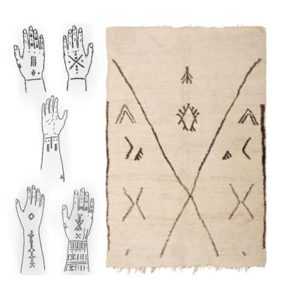
Berber Tattoos and Beni Ourain Rug
The
traditional style and patterns of the Beni Ourain rugs consists of
mostly geometric black or brown lines that create abstract and diamond
shapes on a cream or whitish background. Most of these carpets will not
have a border and some might have fringe while others will not (and some
might have fringe on one end only). The rugs are handwoven and can last
a lifetime if not more.
Originally, these Berber rugs
were used as bedspreads or blankets and not decorative floor coverings.
They had a "loose structure" to conform to the shape of the body and
thick soft pile would be a great way for them to keep warm in the harsh
atmosphere of the Atlas Mountains.
Knots are tied in a very
specific way and the pile is deep or shallow according to the purpose of
the rug. Other designs include talisman symbols, characters from
the Ancient Berber alphabet and geometric patterns reminiscent of the
old Native American, Navajo rug designs.
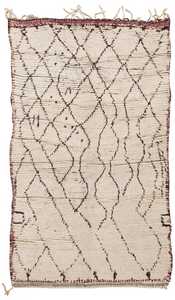
Beni Ourain Rug
The vintage Beni
Ourain rugs are mostly neutral in coloration and abstract in design.
This is why they can be easily incorporated in today's modern decors.
Their versatile modernist look combined with their considerably low
price points, makes them an easy choice for people from all walks of
life.
The vintage Beni Ourain rugs were not mass produced. No two
rugs are alike and all were made to withstand the test of time. There
are many websites and dealers who sell these types of Berber carpets.
Some of the carpets are old,some new and some in the middle but these
factors are important as far as value is concerned. Many Beni Ourain
carpets are from the mid-twentieth century and they are becoming
increasingly difficult to find. Many of the new "Beni Ourain Rugs" are
not made in Morocco but dealers still refer to them as such because the
designs were created to mimic them.
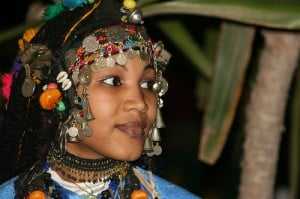
Berber Woman
It
does not take an expert to be able to differentiate between the real
McCoy and the more commercial or even new counterparts. The older ones
have a softer, more supple texture and are far more interesting in
design. In addition, the "real" carpets were never produced wider than
about 7' so if you come across a Beni Ourain rug that is 12 feet by 18
feet (just an example) then the overwhelming chances are that you are
looking at a newly produced carpet that was not even woven in Morocco.
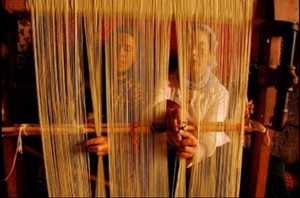
Moroccan Women Preparing To Begin Weaving
Morocco's
magnificent vintage Beni Ourain carpets have a common modernist thread
that links them to world renowned mid century moder designers such as
Alvar Aalto, Le Corbusier, Charles and Ray Eames, Frank Lloyd Wright,
Marcel Breuer and Arne Jacobsen. Shag carpets were the ultimate interior
accessory during the mid-20th century. That said, the sophisticated
nature of the Moroccan Beni Ourain rugs, make them even more luxurious
and tasteful.
Due to their widespread use by the greatest
designers of the 20th century, Morocco's Beni Ourain carpets have become
definitive representations of an era when the classically modern style
was born. These exceptional pieces have rich textures, chic colors and
cryptic surface decorations. This combination of traits makes vintage
Moroccan rugs the ultimate accessory for highlighting the sleek lines of
minimalist decor and proving that less really is more.

Beni Ourian Rug
It
is one of those wonderful and happy accidents of history that the
aesthetic values of a group of semi-nomadic tribal people in Morocco
would be so admired by mid-twentieth century interior designers in North
America and Europe. Indeed, the wonderful series of coincidences that
made for such a fascinating development -- the fact that the Beni Ourain
were shepherds and goatherds with access to fine wool, their location
in the Atlas mountains, their traditional way of life, and the rapid
changes in design that occurred in the post-war period in the Western
World -- is really one of those things that is stranger than fiction,
but very true.
Moroccan rugs in general are beautiful works of folk art.
Made by untrained individuals, in secluded locations, these rugs offer
us a glimpse into the psyche of the artisan who created them. There is
no doubt that they were far more advanced than most people think and it
is this anomaly that fascinates art historians and consumers alike.
In
the end, the demand for quality Moroccan rugs is higher than it has
ever been. Because of the myriad of interesting cultural factors that
have given them their unique and fantastic style, Moroccan rugs are
admired and sought after all over the world, both by experts and by
laypeople intrigued by their timeless and distinctive beauty.
Beni Ourain And Berber Rugs
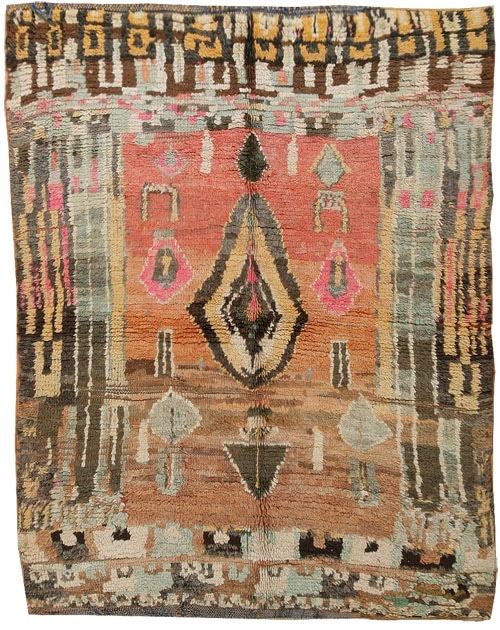
Berber Rugs
Morocco
has a long history of weaving some of the most beautiful rugs in the
world. The ancient weaving started before the 7th Century with the
Berber tribe, people of North Africa who settled in Morocco during this
period. For thousands of years, the women of the tribe have woven
exquisite hand knotted wool rugs inspired by tribal ceremony and
symbolism. The Berber tribe still exists today, living in the Atlas
mountain regions of Morocco, where the ancient weaving techniques are
preserved and passed down from mother to daughter.

Beni Ourain Rugs
The
Berber tribe is still responsible for producing the majority of
handmade Moroccan rugs in our marketplace. Moroccan rugs are unique in
their designs, patterns and colors since each rug is woven without any
diagram or pattern to follow. The weaver interprets important designs
and patterns that are relevant to daily tribal life and reproduces these
motifs in the rug.
Rugs often tell a story of tribal ancestors or
the weaver’s life combined with tribal superstitions that are a strong
part of these remote rural regions. Characterized by geometric patterns
that are often asymmetrical and rich vibrant colors reminiscent of
church stained glass windows, Moroccan rugs work well to accent
contemporary interiors and architecture. Bold colors like reds, oranges,
yellows, blues, greens and purples are mixed with naturals, browns and
blacks representing colors found in nature, plants and wildlife
indigenous to the region of the tribe. The dyes
that produce these vivid colors are made from plants and berries like
henna, madder root, pomegranate, figs and tea leaves found abundantly in
the mountains. The natural and black wool used
comes directly from sheep and goats in the area, like the black-haired
goats that roam and climb the Atlas mountain areas. Each weaver
determines the design, pattern and color as the rug progresses, so no
two rugs are ever alike and each rug can take years to weave. A Moroccan
rug is a one-of-a-kind masterpiece, a work of art,
that will provide beauty for a lifetime. With proper care, colors will
not fade and wool will not wear out, leaving a rug that can be passed
down for generations.
More About The Beni Ourain Rugs
Beni Ourain Rugs - The Beni Ourain is a group
of Moroccan people that is actually comprised of seventeen different
Berber tribes, all of whom hail from that country’s Atlas mountain
range. A semi-nomadic people, the Beni Ourain are primarily shepherds
and goatherds who have historically raised their livestock high in the
mountains, moving with their herds from one graze land to the next. It
is in large part due to the extraordinarily fine wool produced by this
livestock that Beni Ourain have historically produced such fine rugs and
carpets. Because of the diversity of the seventeen different tribes
that make up the Beni Ourain, there is a fascinating and subtle
difference in the patterns and design elements present in the rugs and
carpets that they produced. While some Beni Ourain tribes have preferred
colors – always utilizing natural dyes – other tribes have preferred
monochromatic design elements.
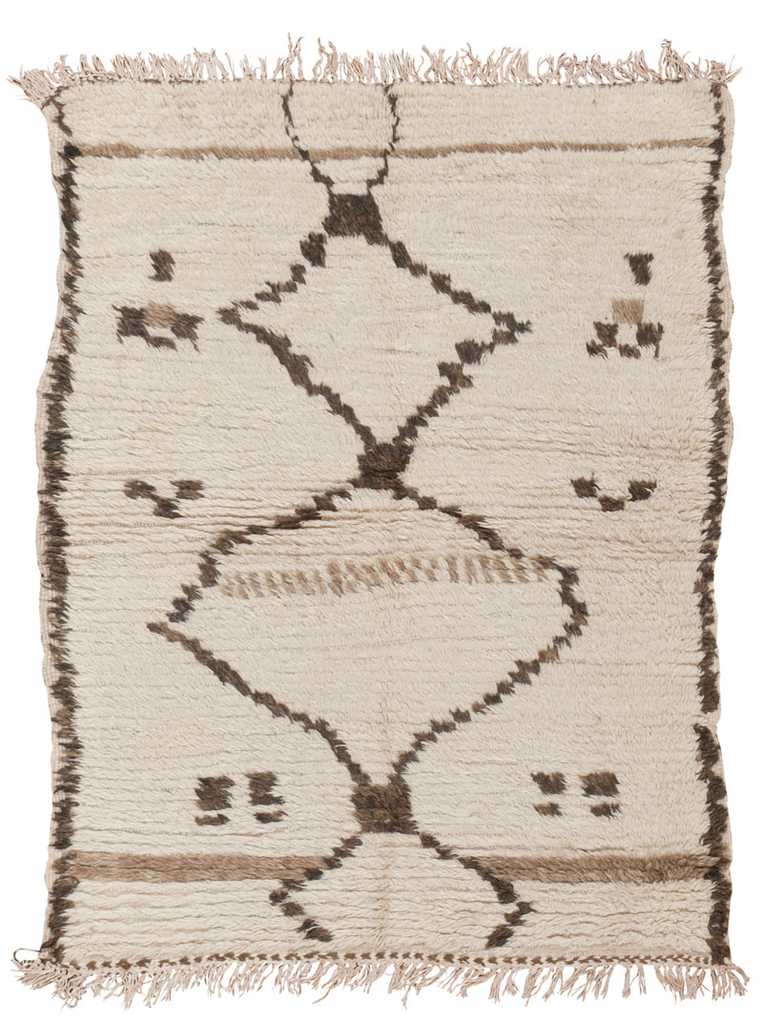
The beautiful vintage Beni Ourain rug showcases their aesthetic values.
Those
rugs and carpets that are most broadly representative of the aesthetic
of the Beni Ourain, however, are those that boast geometric designs:
lines of black or brown that come together to form grid and diamond
patterns. It is a combination of these seemingly disparate factors – the
fine wool harvested by the Beni Ourain and their penchant for abstract,
geometric art – that make Beni Ourain rugs among the most desirable in
today’s rug market. Thick, shaggy rugs with tantalizingly abstract
designs were championed by the leading designers of the mid-twentieth
century, including Frank Lloyd Wright and Le Corbusier, bringing the
ancient Beni Ourain rugs into the forefront of the design world of
today.
It is a fascinating set of historical and cultural
developments that have made Moroccan rugs as popular as they are today.
The Beni Ourain – with a penchant for abstract symbolism and geometry as
well as a steady supply of fine grade wool – happened to be weaving
rugs and carpets that would be perfectly suited to the design aesthetics
of the Western World in the decades following the end of the Second
World War. Moroccan rugs by the Beni Ourain remain among the most
desirable pieces today, and are sought after the world over, both by
experts in antique Oriental rugs and everyday people who appreciate the lasting artistic value of such rugs.